by Ian Sebire
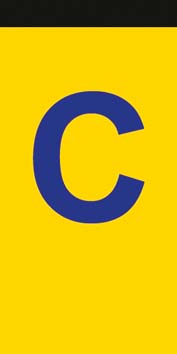
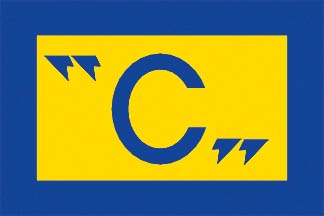 The 1960s witnessed a magnificent, if misguided, flourish of activity in the shipyards of Europe. Nowhere was this more dramatically expressed than in Italy, where a sequence of large, fast and beautifully crafted passenger liners were created. Arguably the best of these was saved until last.
The 1960s witnessed a magnificent, if misguided, flourish of activity in the shipyards of Europe. Nowhere was this more dramatically expressed than in Italy, where a sequence of large, fast and beautifully crafted passenger liners were created. Arguably the best of these was saved until last.
Eugenio C, named after one of the Costa Line’s founding brothers, was built for the family business’ established South America emigrant trade. She was ordered from the prolific Canteiri Runiti dell’ Adriaties (CRDA) yard at Monfalcone, on Italy’s north-eastern seaboard. They had recently completed a fine pair of liners for Lloyd Triestino’s Australia service (Galileo Galilei and Guglielmo Marconi) and were then building Homes Lines magnificent Oceanic, conceived as a two class liner but completed as a one class cruise ship.
Costa’s new flagship took something from each of these vessels and also from near contemporaries, Canberra, Oriana and Leonardo da Vinci. Eugenio C’s hull featured all the elements patented by CRDA’s marine engineer Nicolo Costanzi, including the swan neck bow and composite spoon and transom stern. Unlike Oceanic, her hull incorporated a pronounced sheer and in this respect, as well as the anchors and housings, Costa’s new build hull most closely resembled the Lloyd Triestino twins. One notable difference was the inclusion of a bow anchor, unconventionally stowed in a vertical recessed housing at the prow.
The 217.39 metre (712 foot) hull was named by Donna Pinuccia, wife of company President Angelo Costa, and glided into the glassy waters of the Adriatic on 21st November 1964. Dressed overall with signal flags from stern to stern, like most Italian launchings she was painted in red oxide primer. Some forty years later she would again don a red hull.
Completing the ship took another 21 months. Heading up a design team of rare talent, Costanzi collaborated with architect Nino Zoncada on the exterior and interior layout. Zoncada was responsible for the beautifully rounded, raked superstructure front and co-ordinating swept back bridge wings, streamlining reminiscent of some of the great pre-war liners such as Normandie, Bremen and Europa. Drawing obvious comparisons with the earlier Rotterdam and Canberra, Eugenio C’s twin funnels were positioned athwart the ship. The basic slender pipe arrangement was given a dash of Italian chic by being raked, tapered and with a pronounced outward slant. Designed by the same Turin Polytechnic team responsible for Michelangelo and Raffaello and the Lloyd Triestino twins, each funnel was topped by a grille and fin, to optimise wind flow and smoke dispersal. Ingenious use of dampers meant that in the event of a cross wind, exhaust smoke could be channelled solely through the downwind pipe.
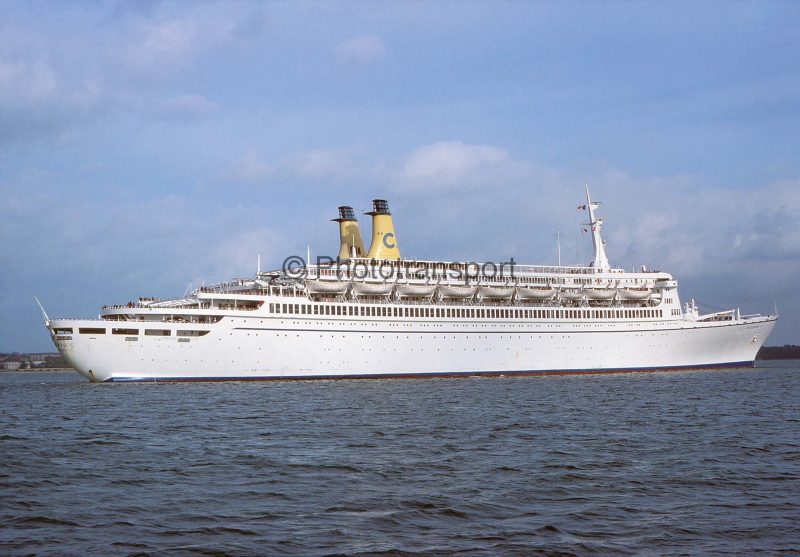
In common with most Italian Liners of the era, there was extensive outdoor deck space and swimming pools provided for each of the three classes. The first class lido area was located amidships between mast and funnels. Given her tropical itinerary it was decided not to incorporate the Magrodome sliding roof arrangement installed on Oceanic, nevertheless all the outdoor areas benefitted from the provision of protective glass screening.
Powered by two sets of CRDA-De Laval geared turbines, she achieved a creditable 28.43 knots on trials, allowing ample reserves above the 27 knot contract speed. It was with immense pride, four days later on 22nd August 1966, that she was formally accepted and welcomed into her home port of Genoa. This was just a short distance from the ancestral homeland of Santa Margherita Ligure on the Ligurain Riviera, where the family’s original olive oil business had developed and thrived. The following day she departed on a shake down cruise to Cannes, Barcelona and Lisbon, before returning to Genoa for provisioning. On 31st August 1966 she was accorded a spectacular send off on her maiden voyage to South America. After calling again at Cannes and Barcelona, she made her final European landfall at Lisbon on 3rd September. To the backdrop of the glittering lights of the Portuguese capital, Eugenio C departed at midnight, glided under the brand new Tagus bridge, and out into the Atlantic.
The following morning those fortunate first passengers woke to sample the delights of life at sea on board the Costa flagship. A relatively smooth crossing was guaranteed thanks to the installation of two pairs of Denny-Brown fin stabilisers, as she gathered pace on a south-westerly course for Brazil. Accommodation was provided for a total of 1,659 passengers. Reflecting the requirements of what remained a significant emigrant trade, only 214 berths were for first class passengers, located on sun and boat decks. These cabins included eight luxury apartments named after famous Italian resorts, four of which featured a living room, curtained off bedroom and large bathroom. Situated at the front of the superstructure, the four larger suites also had full height picture windows offering dramatic views over the bow. All first class cabins had private facilities. The residual 1,445 berths were sub-divided into the equivalent of second and third class, although reflecting the more egalitarian times, these were actually called Tourist A and Tourist B. Located in a quieter, central position the 374 Tourist A passengers occupied larger cabins, with their own en-suite facilities. The residual 1,071 Tourist B passengers were housed in 4 to 8 berth cabins, lower in the fore and aft parts of the hull. Many of these had their own bathrooms but 122 cabins used communal baths and toilets. Although nominally reminiscent of the class divisions of old, there was little comparison to conditions earlier in the century, where the privileged and well-heeled enjoyed huge swathes of opulently decorated deck space, whilst emigrants were crammed like cattle into steerage dormitories. Tourist B was far from Spartan and to impoverished, departing emigrants offered a level of accommodation and facilities beyond any previous experience.
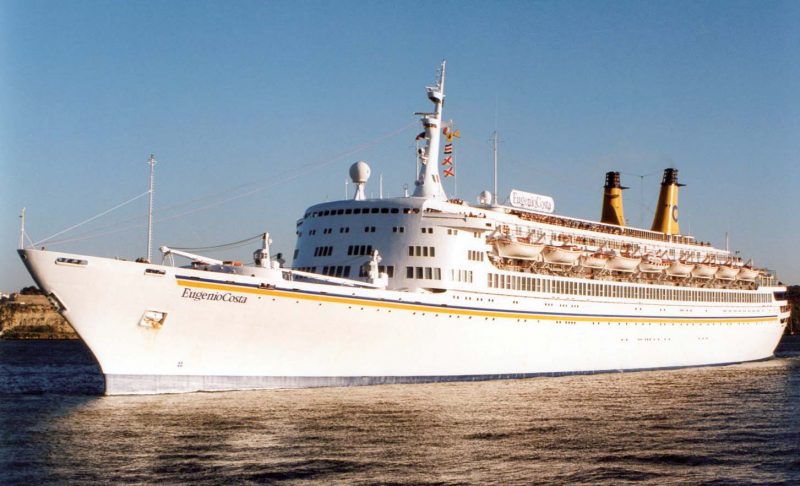
With the exception of restaurants, public rooms for all passengers were located on Salon deck, with first class accommodation above and tourist class below. Costa entrusted the interior design and décor exclusively to Nino Zoncada, who had so successfully fulfilled the role on the company’s previous new build, Federico C. Eugenio C was perhaps the pinnacle of his career, with a series of eight, elegant, modern and beautifully furnished public rooms. Harmonious and coherent were the adjectives most often associated with the new flagship’s décor, avoiding the sometimes jarring contrasts that resulted when a disparate team of designers were employed. All the rooms were named and themed around precious or semi-precious stones, progressing aft from the first class Ambra Ballroom, through the Rubio and Opale lounge amidships to the expansive Turchese Lounge and Ballroom. The oval Ambra Lounge was formed by the ship’s forward bulkhead with large picture windows on three sides. This was the one lounge with direct sea views, all the others were surrounded by a traditional, enclosed promenade, part of which was set aside as a lush winter garden. Combining colour co-ordinated chairs and curtains, Zoncada also championed the best contemporary Italian artists, commissioning works by Massimo Campigti in the Ambra Lounge, Emmanuele Luzzati in the Rubino Lounge and Marcello Maschierini in the Turchese and Opale Lounges. Despite the archetypal linoleum flooring, the ship had a warm and luxuriant atmosphere.
Shortly after 7 a.m. on 9th September, Eugenio C entered the port of Rio de Janeiro, rounded Sugar Loaf mountain and docked in the shadows of Corcovado and the iconic statue of Christ the Redeemer. Her passage time had been six and a half days, averaging 27.5 knots. This was the last of the trans-ocean speed records to be broken by a liner on regular service, and unlike the Blue Riband of the North Atlantic has never been bettered by any other vessel. From Rio, Eugenio C skirted the Brazilian coast to Santos, before heading south to the River Plate and its sentinel capital cities Montevideo (Uruguay) and Buenos Aires (Argentina). She stayed three days in the Argentine capital and was opened to the inquisitive public, with 15,000 making the traditional donation to seamen’s charities in return for a glimpse inside. Although the fastest, Eugenio C was not the largest liner ever on the Europe to South America service. That distinction went to the oddly angular, pre-war French Liner, L’Atlantique, a magnificent art deco vessel that succumbed after only two and a half years of service, to the bête noire of French passenger shipping, fire.
Costa’s one concern about their new flagship was vibration, somewhat ironic given Constanzi’s role in resolving the same problem on Italia’s Michelangelo and Raffaello. A solution was quickly found, and during her first dry-docking in October 1967 new six-bladed propellers were fitted. The advent of Eugenio C resulted in a reshuffle of tonnage throughout the Costa fleet. Although a direct replacement for the Bianca C, which had been lost to fire off Grenada on 23rd October 1961 (the ensuing insurance pay out had partly funded the new ship), Eugenio C directly took over the South America service from the previous flagship and earlier company new build, Federico C. This 20,000 ton ship repositioned to Bianca C’s Central and North America service. Eugenio C’s running mate was to be the recently acquired 15,889 ton Enrico C. Formerly a competitor, she had been introduced as Provence in 1951 for the SGTM (Societé Générale de Transports Maritime) service from Marseilles to Buenos Aires, operating in tandem with sister ship Bretagne. In 1961, both ships were withdrawn but after a brief refit Provence was back, as part of a joint venture with Costa. Four years later, SGTM decided to close down it’s operations and Costa acquired the ship, sending her to the Marriotti yard for a $12 million rebuild. Renamed Enrico C, she made her maiden voyage to South America just 3 months before Eugenio C, on 23rd May 1966. Although only half the size of the Eugenio C and unable to match her pace, Enrico C proved to be a dependable and popular consort, in the face of direct competition from the Italian Line’s Augustus and Guilio Cesare.
Eugenio C quickly settled into her new role and was the most popular vessel on the South America run. First class was the preserve of the well-heeled and well connected including captains of business, diplomats and senior church officials. Tourist A and B attracted their subordinates, emigrants (southbound), reverse migrants (northbound) and of course, tourists.


Eugenio C also proved herself a fine cruise ship. The first such voyage was a 34 night, 15 port circumnavigation of continental Africa, which left Genoa on 9th January 1967. Repeatedly the following year, the liner was soon seen in a range of locations, as diverse itineraries incorporated calls at Mediterranean, Caribbean, African, North European and even Pacific ports. By the mid 1970s she was spending increased time on the single class cruise circuit but nevertheless included half a dozen round trip voyages to Buenos Aires per year. On 3rd October 1977 Eugenio C cast off from Genoa with 850 passengers on a very special voyage, her maiden world circumnavigation. Heading east, she made for Alexandria before transitting the Suez Canal en route to Bombay and Colombo on the Indian sub-continent. In South East Asia she called at Penang, Singapore, Bangkok, Manila and Hong Kong. Skirting the Chinese coast she set course for Kobe and Yokohama in Japan, before crossing the Pacific, stopping at Honolulu en route. Sweeping under the Golden Gate Bridge, Eugenio C made landfall on the American continent at San Francisco, then nearby Los Angeles, before making for the Mexican ports of Acapulco and Cartagena. After passing through the Panama Canal she stopped at St Thomas, before steaming across the Atlantic, directly to Genoa.
Also in 1977 the state funded shipping conglomerate FINMARE’s retrenchment program was in full swing. This included the withdrawal of Italian Line services to La Plata, then entrusted to the very popular Cristoforo Columbo and, making the very last liner voyage, Guglielmo Marconi. With Enrico C ostensibly a full-time cruise ship, Eugenio C maintained the maritime link between Europe and South America alone. By the turn of the decade she was the only three class liner left in service, and one of the very few making regular, scheduled, transoceanic crossings. The maritime link between Europe and South America was dying, an inevitable consequence of airline competition, colonial withdrawal and the acceleration of modern living. In 1982, three crossings took place but Costa was forced to cancel a fourth due to the close proximity of the Falklands War, and inevitable tension in the South Atlantic. This was particularly pertinent given her superficial resemblance to Canberra, the British troop ship affectionately known as the Great White Whale, which was then steaming south filled with Paras and Marines.
From 1983, all demarcation barriers between the classes were permanently removed as Eugenio C became a full-time cruise ship, with just two repositioning voyages per year between Genoa and Buenos Aires, south in the autumn and northbound in the spring. Apart from enduring her share of inclement weather, Eugenio C’s career had been largely incident free, until boxing day 1984. At 9 p.m. that evening, having recently left Rio de Janeiro for her annual Christmas cruise, the Costa flagship was heading dead slow out of port when passengers noted the ship juddering. It transpired two Brazilian warships on manoeuvres in the area had strayed into the exit channel reserved for merchant shipping. One, the veteran destroyer Sergipe, struck the Eugenio C’s bow and scraped along to a point just below the bridge wing before the two vessels became disentangled. To assess for damage, the Costa flagship turned about and retuned to Rio, where repairs were affected whilst passengers remained on board.
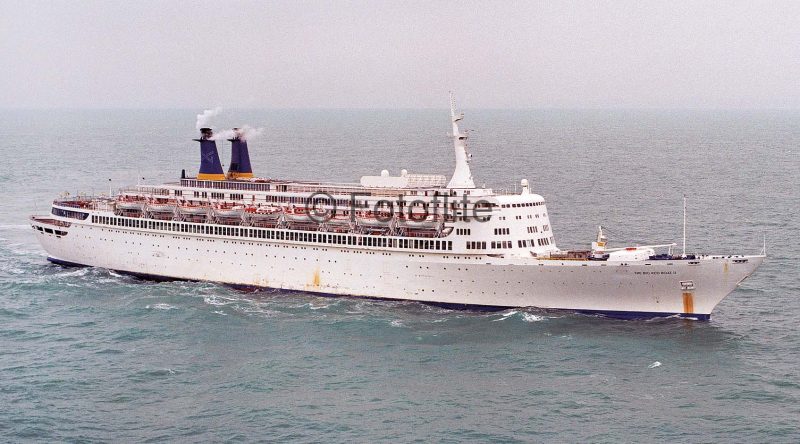
As Eugenio C sailed into her third decade of service Costa planned a series of modifications, designed to meet her new role in the highly competitive global cruise market. In October 1986, she was taken to the Marriotti shipyard where her powerful 60,000 shp turbines were de-rated to a maximum output of 39,000 shp. Despite this she was subsequently no slouch, still capable of 24 knots. Further mechanical changes included the installation of a bow thruster, to assist manoeuvring in the tight confines of cruise ports and anchorages. The galleys were gutted and the most modern food preparation and distribution equipment installed, whilst 70 of the original 122 ‘no facility’ cabins were provided with bathrooms. Externally the most visible alteration was at the stern, where the now redundant Tourist B swimming pool and lido was removed and replaced by a full-sized tennis court (one of very few aboard a ship, most notably on the top decks of the pre-war Normandie and Empress of Britain). In fact within a year the tennis court would be subsumed within the largest single aspect of refurbishment expenditure. Once again back at the Marriotti yard in October 1987, the former Tourist class lido was stripped back and a prefabricated structure hoisted into its place. Although neatly curved, with darkened glass to blend in with the stepped after decks, this extension to the lounge deck inevitably marred the ship’s svelte profile. The new space became a 600 seat show lounge, whilst the adjoining former Tourist B public rooms, including the original Turchese Lounge, were transformed into an open plan ‘Piazza’. On 1st December 1987, bearing the name Eugenio Costa, the refurbished liner re-entered service. Over the next seven years she toured the globe, her elegant lines in sharp contrast to the bulky profiles of her more modern fleet mates. Nevertheless looks do not bring profits and her aging, thirsty turbines and high crew ratio meant she was an expensive ship to run.
In 1993 Costa earmarked Eugenio Costa for its short-lived joint venture called American Family Cruises. In the end only fleet mate Costa Riviera (formerly Lloyd Triestino’s Guglielmo Marconi) was refitted but lasted less than a year in the new role. With poor forward bookings, she reverted to Costa colours in October 1994. That same month Eugenio Costa was given a further $20 million refit at the INMA yard at La Spezia. On completion of the work, at the beginning of December, she left Genoa for Buenos Aires and the start of a Winter cruise program. Considering Costa had been debating their flagship’s future for several years, the extent and cost of the refit seems surprising.
In fact as she steamed for the South Atlantic it transpired Eugenio Costa was under new ownership and flying the Liberian flag. Mascot Shipping SA of Monrovia was a subsidiary of the Bremer Vulkan shipyard and Eugenio Costa had been sold in part payment of a new 76,000 ton sister to the recently completed Costa Victoria. Under the terms of the sale, Costa chartered their former flagship back, to complete her scheduled cruise programme. With former running mate Enrico Costa having been sold in 1994, Eugenio Costa was the last classic liner in a very different looking fleet. Soon the company would be consumed by the voracious Carnival Corporation, leading to even more investment in new tonnage. Unceremoniously, Eugenio Costa was laid up at Genoa on 1st November 1996 having completed her final Mediterranean cruise. That same autumn the other ‘tanker funnelled’ stalwart Canberra was retired and sent to the scrap yards of Gadani Beach in Pakistan This appeared to be the most obvious destination for Eugenio Costa but in fact the P&O veteran’s departure would indirectly allow her Italian counterpart a reprieve. On 12th February 1997, Eugenio Costa was purchased by UK based Lowline Shipping, Bremer Vulkan having gone bankrupt the previous year. Regrettably it was a story that would be repeated several times over the rest of her career, as if she was the carrier of some incurable disease, called financial ruin.
Sent for a further refit, Lowline Shipping’s new acquisition emerged as Edinburgh Castle, with an all white livery and an attractive deep blue and golden yellow funnel. Her first employment between January and March 1998 was on one night gambling cruises out of New York, hardly the most salubrious start to her new life. In fact Lowline had secured a long term charter to a new player in the UK cruise market, Direct Cruises. Having started advertising in August 1997, this venture was a spin-off from the highly successful Direct Holidays. The concept was simple, by marketing their cruises directly, the company avoided paying agent’s commission and could pass those savings on to the customer, thereby undercutting competitors. They cited the withdrawal of Canberra and CTC’s Southern Cross as creating a void in the market, their aim was to offer a service comparable to P&O’s Victoria, at CTC prices. A further selling point was Direct Cruises decision to position Edinburgh Castle to sail out of Liverpool and Greenock (close to the company headquarters in Glasgow). Within weeks the programme was sold out, so to cope with demand, in December 1997, Direct Cruises secured a five year charter of Apollon, originally Canadian Pacific’s Empress of Canada. The optimism was short-lived. Having ended her New York cruise programme, Edinburgh Castle steamed across the Atlantic arriving at Cammel Laird’s Birkenhead yard on 31st March 1998, before starting the Direct Cruises charter. Teething problems are an inevitable part of any new venture but unwanted and often unwarranted criticism from a merciless press, is even more harmful. Thirty passengers (from a complement of over a thousand) understandably refused to travel on Edinburgh Castle’s maiden voyage from Liverpool, after a burst pipe flooded several cabins. Of course those 3% garlanded the headlines, whilst by all accounts the majority of the remaining 97% had a largely enjoyable holiday. Unfortunately, continued mechanical and plumbing problems plagued that maiden season, disrupting schedules and involving costly repairs. Fleet mate Apollon was similarly afflicted, her early cruises cancelled through a combination of boiler breakdowns and delays in fitting out.

With Apollon’s woes still prominent and just as she appeared to be settling down into her new role, Edinburgh Castle suffered a complete loss of electrical power on 24th May 1998, due to her main switchboard short circuiting. Although temporarily rectified, it was decided to return to Liverpool and the ship was sent for permanent repairs. With full refunds, compensation and the offer of a free 10 day cruise, passengers could hardly complain but inevitably some still did. A month later and more bad news. It transpired that two former passengers had contracted Legionnaires disease (though on different cruises, one in April and one in June). Whilst no direct link could be traced, sample testing identified traces of legionella bacteria in the drinking water system. When the ship docked at Greenock on 28th June 1998 the passengers and crew disembarked, and the water system was purified but with the BBC headlining ‘UK Passengers Leave Legionnaire Liner’, Edinburgh Castle’s reputation was in tatters. Further electrical problems in September compounded the problem so that on 14th October, at the end of her advertised cruise programme, the ship arrived at Southampton for repairs and an extensive two month overhaul. For Lowline Shipping it was the final straw, the costly refit also deprived the company of a lucrative charter. After being placed under arrest for unpaid debts, Lowline went into receivership and ownership of Edinburgh Castle passed to their biggest creditor, Cammell Laird.
Direct Cruises had advertised a programme of 14 trips on Edinburgh Castle for 1999, starting on 27th March and running through to the end of October. Advanced bookings were positive with a high proportion of repeaters but it was all for nought. With Lowline shipping’s demise the charter was terminated and Cammell Laird gave the ship a further thorough US$25 million overhaul, in preparation for her next employment. On completion of the refit, Cammell Laird chartered their new acquisition to Premier Cruise Lines. Repainted with their ubiquitous bright red hull, and bearing the unimaginative name Big Red Boat II, her soul was sold for survival. At least she found herself in familiar company, Premier had become the ultimate destination for an assortment of classic 1950s and 1960s liners including not only fellow Italian’s Oceanic and Federico C, but also Rotterdam, Transvaal Castle and Infante dom Henrique. Once again the former Eugenio C gravitated towards a company on the brink. In September 2000, Premier Cruises went into liquidation, briefly Big Red Boat II was chartered to the US Government, before joining her redundant fleet mates in lay-up at Freeport in the Bahamas.
Cammell Laird retained ownership, actively seeking further charters and keeping her well maintained. Pullmantur considered acquiring her but were put off by her costly, temperamental machinery (eventually they successfully operated her older but more reliable near sister, Oceanic). In 2003, Cammell Laird sold the Big Red Boat II to Argo Ship Management but the new owners were also unable to secure a charter. Maintenance was compromised and the ship’s overall condition rapidly deteriorated. That final voyage to the breakers became inevitable. With the abbreviated name Big Red, her departure from Freeport in April 2005 was notable for the great plumes of dense black smoke, which drifted across the port from her twin funnels.
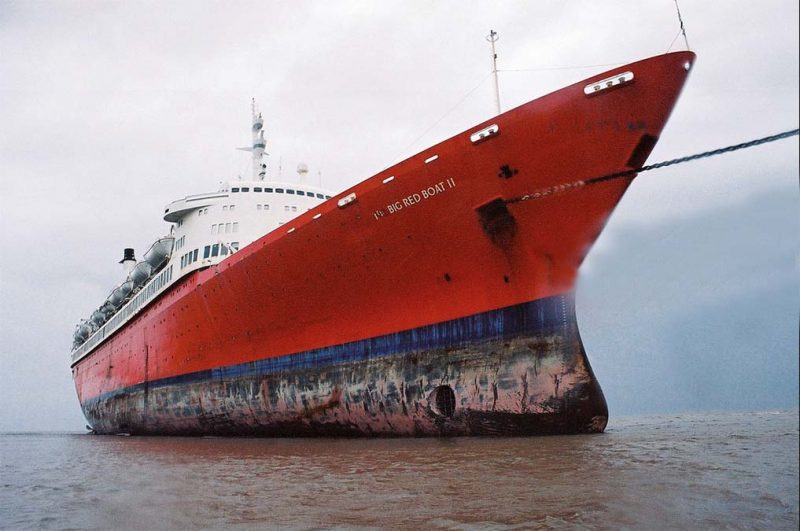
Under her own steam, she crossed the Atlantic, bunkering in the Azores and continued east, to India, anchoring off the beaches of Alang on 5th June 2005. Two days later, amidst further belching smoke, she weighed anchor and was driven onto the oily, debris-strewn sands. As her keel shuddered to a standstill ‘finished with engines’ was rung up for a final time, the one time ‘Queen of the South Atlantic’ succumbed to the breakers.






Comments
Sorry, comments are closed for this item